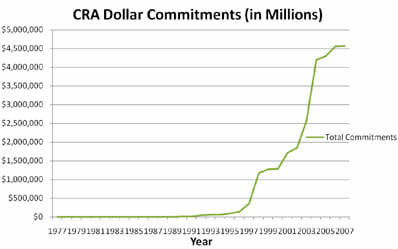The CRA and the Mortgage Meltdown
There always have been good, logical reasons to discuss the Community Reinvestment Act (CRA) as one contributor to the mortgage meltdown last year. After all, the act is effectively a prod to banks to lend to people who would not normally meet their lending criteria, and to do so on terms (e.g. no money down) they might not usually offer.
The usual response from supporters is that the numbers are too small to matter. I tended to agree with this -- until I saw this graph, from Peter Schweizer via Carpe Diem.

Unfortunately he does not have a source or methodology, so I have to retain some skepticism, but if true these numbers are far from trivial. He writes:
According to the National Community Reinvestment Coalition, in the first 20 years of the act, up to 1997, commitments totaled approximately $200 billion. But from 1997 to 2007, commitments exploded to more than $4.2 trillion. (Keep in mind this is more than four times the size of the current health bill being debated in Congress.) The burdens on individual banks can be enormous. Washington Mutual, for example, pledged $1 trillion in mortgages to those with credit histories that "fall outside typical credit, income or debt constraints," and was awarded the 2003 CRA Community Impact Award for its Community Access program. Four years later it was taken over by the Office of Thrift Supervision.
This effort was backed by a parallel effort at Fannie Mae and Freddie Mac to buy up these loans:
Beginning in 1992, Congress pushed Fannie Mae and Freddie Mac to increase their purchases of mortgages going to low and moderate income borrowers. For 1996, the Department of Housing and Urban Development (HUD) gave Fannie and Freddie an explicit target "” 42% of their mortgage financing had to go to borrowers with income below the median in their area. The target increased to 50% in 2000 and 52% in 2005.
For 1996, HUD required that 12% of all mortgage purchases by Fannie and Freddie be "special affordable" loans, typically to borrowers with income less than 60% of their area's median income. That number was increased to 20% in 2000 and 22% in 2005. The 2008 goal was to be 28%. Between 2000 and 2005, Fannie and Freddie met those goals every year, funding hundreds of billions of dollars worth of loans, many of them subprime and adjustable-rate loans, and made to borrowers who bought houses with less than 10% down.
Fannie and Freddie also purchased hundreds of billions of subprime securities for their own portfolios to make money and to help satisfy HUD affordable housing goals. Fannie and Freddie were important contributors to the demand for subprime
securities.
Obama has a personal history with this effort, actually suing banks who would not provide the sub-prime lending that he later, as President, blamed them for undertaking
Obama's battle against banks has a long history. In 1994, freshly out of Harvard Law School, he joined two other attorneys in filing a lawsuit against Citibank, the giant mortgage lender. In Selma S. Buycks-Roberson v. Citibank, the plaintiffs claimed that although they had ostensibly been denied home loans "because of delinquent credit obligations and adverse credit," the real culprit was institutional racism. The suit alleged that Citibank had violated the Equal Credit Opportunity Act, the Fair Housing Act and, for good measure, the 13th Constitutional Amendment, which abolished slavery. The bank denied the charge, but after four years of legal wrangling and mounting legal bills, elected to settle. According to court documents, the three plaintiffs received a total of $60,000. Their lawyers received $950,000.
Now, Congress and Obama want to strengthen the CRA -- talk about not learning from mistakes.
Now comes Rep. Eddie Bernice Johnson, D-Texas, and 50 other co-sponsors (all Democrats) of H.R. 1479 the "Community Reinvestment Modernization Act of 2009," who want to expand the CRA to include not just banks but also credit unions, insurance companies and mortgage lenders. Congressman Barney Frank, chairman of the House Financial Services Committee, has supported the idea in the past. The SEIU and ACORN, along with a host of other activist groups, are also behind the effort.
President Obama has been a staunch supporter of the CRA throughout his public life. And his recently announced financial reforms would make the law even more onerous and guarantee an explosion in irresponsible lending. Obama wants to take enforcement of the CRA away from the Federal Reserve, the FDIC and other financial regulators who at least try to weigh bank safety and soundness when enforcing the law, and turn it over to a newly created Consumer Financial Protection Agency (CFPA). This agency's core concerns would not be safety and soundness but, in the words of the Obama administration, "promoting access to financial services," which is really code for forcing banks to lend to those who would not ordinarily qualify. Compliance would no longer be done by bank examiners but by what the administration calls "a group of examiners specially trained and certified in community development" (otherwise called community activists). The administration says, in its literature about the reforms, that "rigorous application of the Community Reinvestment should be a core function of the CFPA."
Looks like there may be jobs available after all for all those folks who got fired from ACORN.
Does more government control and less consumer choice sound familiar? The Consumer Financial Protection Agency (CFPA) is designed to regulate consumer financial products. We need to support effective consumer protection that ensures concise disclosures about risks associated. Visit http://www.friendsoftheuschamber.com/issues/index.cfm?ID=469
My educated guess is that the gub'mint expanded what is considered qualified CRA lending. There are lots of SBA initiatives and SBICs created recently that accept commercial bank investments to their funds as CRA-qualified loans.
These projects probably tend to be more economically viable than a typical CRA loan. I just don't know to what magnitude this explains the increase (because it is massive!).